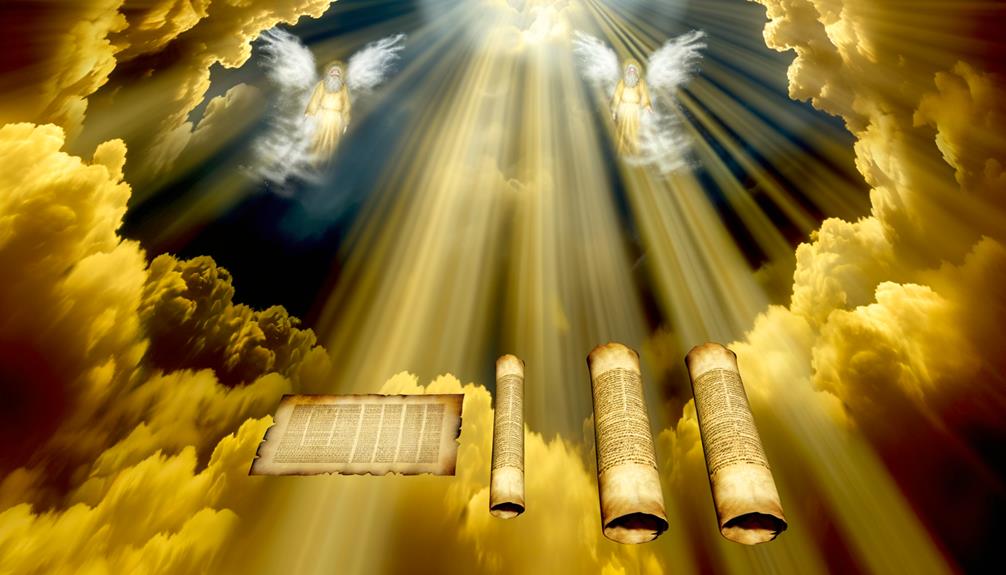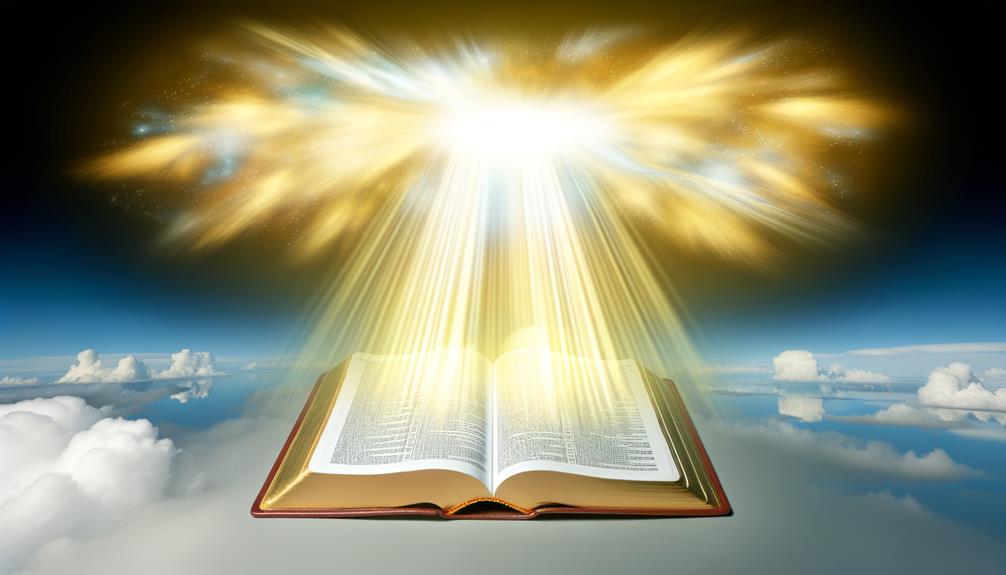Meaning of the Word Glory in the Bible: Divine Presence
In the Bible, the word ‘glory’ refers to the manifest presence and radiant splendor of God’s essence, revealing His weightiness, honor, and majesty. Rooted in the Hebrew ‘kavod’ and Greek ‘doxa,’ it encompasses both God’s inherent attributes and their visible impact on creation.
It is manifested through awe-inspiring phenomena such as the Burning Bush, theophanies, and the Transfiguration of Christ. Biblical texts like Exodus 24:17 and John 1:14 illustrate this divine revelation.
The robust concept extends through both Covenants, embodying God’s power, covenantal presence, and ultimate sovereignty. These insights highlight the profound layers of biblical ‘glory.’

Meaning of the Word Glory in the Bible: Definition and Spiritual Significance
| Aspect | Description |
|---|---|
| Definition | The manifestation of God’s presence, majesty, and divine splendor |
| Hebrew Term | Kabod – meaning weight, honor, or importance |
| Greek Term | Doxa – meaning praise, honor, or divine radiance |
| Key Themes | God’s majesty, holiness, power, and honor |
| Biblical Examples | Moses seeing God’s glory (Exodus 33:18-23), Jesus’ transfiguration (Matthew 17:1-5) |
| Spiritual Significance | Reflects God’s supreme authority and divine nature |
| Human Response | Worship, reverence, and living to glorify God |
Definition of Glory

In biblical terminology, ‘glory’ commonly refers to the manifest presence and radiant splendor of God’s divine essence. This concept is rooted in the Hebrew word ‘kavod,’ which implies weightiness, honor, and majesty.
The New Covenant counterpart, ‘doxa,’ further encapsulates notions of brilliance and magnificence. Scripturally, glory denotes both God’s inherent qualities and His visible manifestations to humanity. It encompasses His moral perfection, authority, and transcendence.
Theologically, glory signifies divine revelation and the awe-inspiring impact of God’s presence on His creation. This dual aspect—God’s intrinsic worth and His external manifestation—forms a foundational element in understanding His interaction with the world, underscoring His supreme and revered nature in biblical thought.
Glory in the Old Testament

In the Old Scripture, the concept of glory is intrinsically linked to the manifestation of divine presence, as exemplified in the theophanies experienced by figures such as Moses (Exodus 24:15-18).
This manifestation is often depicted through awe-inspiring phenomena, illustrating God’s majestic splendor and sovereign authority.
In addition, the Hebrew term ‘kavod,’ frequently translated as glory, conveys a sense of weightiness and honor that underscores God’s supreme significance and holiness within the covenantal narrative.
Divine Presence Manifestation
The Old Covenant frequently portrays God’s glory as a tangible manifestation of His divine presence and power among His people. This concept is evident in several key instances throughout the Old Scriptures:
- The Burning Bush (Exodus 3:2-5): God’s glory is revealed to Moses in the form of a bush that burns without being consumed.
- The Pillar of Cloud and Fire (Exodus 13:21-22): The Israelites are guided by a pillar of cloud by day and fire by night, symbolizing God’s presence.
- Mount Sinai (Exodus 24:16-17): God’s glory envelops Mount Sinai, signifying His covenant with Israel.
- The Tabernacle (Exodus 40:34-35): The glory of the Lord fills the Tabernacle, indicating His dwelling among the people.
These manifestations underscore God’s commitment to His covenant community.
God’s Majestic Splendor
Reverberating through the pages of the Old Scripture, the concept of God’s majestic splendor encapsulates the awe-inspiring and transcendent nature of His divine glory.
The Hebrew term ‘kavod’ often denotes this splendor, signifying weightiness and honor. Scriptural instances, such as Exodus 24:17, depict God’s glory as a consuming fire on Mount Sinai, illustrating His overpowering presence and holiness.
Similarly, Isaiah 6:3 proclaims, ‘Holy, holy, holy is the Lord Almighty; the whole earth is full of His glory,’ emphasizing His pervasive sovereignty. The Psalms frequently extol God’s majesty (e.g., Psalm 19:1), reinforcing the inherent magnificence of His essence.
Consequently, God’s majestic splendor in the Old Scriptures serves as a demonstration of His omnipotence and unparalleled grandeur.
Glory in the New Testament

Throughout the New Covenant, the concept of glory is intricately linked to the revelation of God’s presence, power, and redemptive work through Jesus Christ. The New Scripture elucidates this through various dimensions:
- Incarnation: The glory of God is manifested in the person of Jesus Christ (John 1:14).
- Transfiguration: Christ’s divine nature is revealed through His transfiguration, showcasing heavenly glory (Matthew 17:2).
- Resurrection: The resurrection of Jesus symbolizes ultimate victory and divine glory (Romans 6:4).
- Second Coming: The anticipated return of Christ is depicted as a glorious event, signifying the fulfillment of divine promise (Titus 2:13).
These facets illustrate that glory in the New Scripture is central to understanding Christ’s divine mission and the transformative impact on believers.
Divine Presence and Glory

The concept of divine presence and glory is deeply intertwined in the biblical narrative, manifesting through various instances of God’s interaction with humanity.
Scriptural accounts, such as the theophanies in the Old Covenant and the transfiguration of Christ in the New Covenant, exemplify how God’s glory is revealed to His people.
Moreover, the manifestation of glory in worship settings underscores the significance of God’s immanent and transcendent presence among believers.
Biblical Examples of Glory
Instances of divine presence and glory in the Bible reveal profound interactions between God and humanity, manifesting in various forms such as fire, cloud, and light. These manifestations serve as tangible representations of God’s majesty and holiness.
- The Burning Bush (Exodus 3:2): God appeared to Moses in a bush that burned without being consumed, symbolizing His enduring presence and sanctity.
- The Pillar of Cloud and Fire (Exodus 13:21-22): Guiding the Israelites, this dual form provided direction and protection, embodying divine guidance.
- Mount Sinai (Exodus 19:18): The mountain quaked and was enveloped in smoke and fire, showcasing God’s powerful and awe-inspiring presence.
- The Transfiguration (Matthew 17:2): Jesus’ face shone like the sun, and His clothes became dazzling white, signifying His divine nature and glory.
These instances underscore the multifaceted nature of God’s glory as depicted in Scripture.
Manifestation in Worship
In worship, the manifestation of divine presence and glory serves as a profound reminder of God’s holiness and majesty, deeply influencing the spiritual experience and practice of believers.
Scripturally, this is evident in passages such as Isaiah 6:1-4, where the prophet encounters God’s glory filling the temple, leading to reverence and awe. This divine manifestation evokes a sense of humility and repentance among worshippers, aligning their hearts with God’s will.
The New Covenant reinforces this concept, as seen in Revelation 4:11, where heavenly beings continually declare God’s glory.
Consequently, worship becomes a transformative encounter, where the perceived presence of God’s glory cultivates an atmosphere of sanctity, reverence, and profound spiritual renewal among the faithful.
Glory in Old Testament
Building upon the profound impact of divine manifestation in worship, the Old Scripture provides foundational narratives where God’s presence and glory are vividly depicted, profoundly shaping the spiritual identity and practices of the Israelite community.
The Old Covenant reveals God’s glory in multiple instances, emphasizing His omnipotence and sanctity. Key examples include:
- Exodus 24:16-17 – God’s glory appears on Mount Sinai, enveloping it in a cloud.
- 1 Kings 8:10-11 – The glory of the Lord fills Solomon’s Temple, signifying divine approval.
- Isaiah 6:1-4 – Isaiah’s vision of the Lord’s glory, illustrating His holiness.
- Ezekiel 1:28 – Ezekiel’s encounter with the divine glory, symbolizing God’s sovereignty.
These instances underscore the integral role of divine glory in Israelite theology and practice.
Manifestation of God’s Power

Throughout the Bible, the manifestation of God’s power serves as a profound witness to His divine glory, often demonstrated through miraculous events and acts of deliverance.
In Exodus 14:21-22, the parting of the Red Sea epitomizes divine intervention, showcasing God’s sovereignty over nature. Similarly, in 1 Kings 18:38, the fire from heaven that consumed Elijah’s offering reveals God’s supremacy over false idols.
The New Covenant continues this theme, as seen in Jesus’ miracles, such as the healing of the blind in John 9:6-7, which illustrates divine compassion and authority.
These scriptural instances underscore the intrinsic link between God’s omnipotence and His glory, encouraging believers to recognize and revere His unparalleled power.
Human Glory and Honor

In addressing the concept of human glory and honor within the biblical narrative, it is imperative to examine instances where individuals receive recognition from both divine and human perspectives.
Scriptural accounts, such as the rise of King David, highlight how human glory can align with divine favor.
Conversely, episodes like the Tower of Babel underscore the perils of human pride and vanity when glory is sought apart from God.
Biblical Examples of Glory
Numerous passages in the Bible illustrate the concept of human glory and honor, often highlighting the complex interplay between divine favor and individual merit. Key examples encapsulate this theme:
- Joseph’s Rise to Power: Elevated by Pharaoh due to his God-given ability to interpret dreams (Genesis 41:39-41).
- David’s Kingship: Anointed by God and celebrated by Israel for his leadership and victories (1 Samuel 16:13; 2 Samuel 5:3).
- Solomon’s Wisdom: Esteemed for his divinely granted wisdom, attracting global admiration (1 Kings 3:12-13; 1 Kings 10:24).
- Esther’s Courage: Honored for her bravery in saving her people, earning favor from the king (Esther 5:2-3; Esther 8:15-17).
These narratives underscore the synthesis of divine blessing and human virtue in achieving glory.
Human Pride and Vanity
Human pride and vanity, when pursued for personal glorification rather than divine honor, are frequently admonished in the scriptures as pathways to spiritual downfall.
Proverbs 16:18 warns, ‘Pride goes before destruction, a haughty spirit before a fall,’ underscoring the peril of self-exaltation. In the New Covenant, James 4:6 reminds believers that ‘God opposes the proud but shows favor to the humble.’
The narrative of King Nebuchadnezzar in Daniel 4 illustrates the divine consequences of human arrogance, where his pride led to his downfall and subsequent humbling.
Scripturally, true glory is reserved for God, and human attempts to usurp this divine attribute through vanity result in estrangement from the Creator and spiritual desolation.
Glory in Worship

The concept of glory in worship occupies a central place in biblical theology, reflecting God’s manifest presence and the believers’ response to His divine majesty.
Scriptural references underscore how worshipers encounter God’s glory through numerous dimensions:
- Revelation: God’s glory is revealed in worship settings, as seen in Isaiah 6:1-4 where Isaiah witnesses the Lord’s majestic presence.
- Praise: Psalm 29:2 calls believers to ‘Give unto the Lord the glory due unto his name; worship the Lord in the beauty of holiness.’
- Transformation: 2 Corinthians 3:18 speaks of believers being transformed ‘from glory to glory’ through worship.
- Communion: Worship facilitates a deep communion with God, exemplified by John 4:24, which emphasizes worship in ‘spirit and in truth.’
These elements illustrate the profound symbiosis between divine glory and human worship.
Glory in Prophecy

Biblical prophecy intricately intertwines with the concept of glory, depicting future revelations of God’s majestic presence and ultimate reign.
Scriptural texts such as Isaiah 60:1-3 and Ezekiel 43:2-5 foretell a time when God’s glory will be manifest in full splendor, illuminating nations and transforming the world.
Prophecies often highlight the eschatological hope that God’s glory will culminate in a renewed creation, free from suffering and sin.
Daniel 7:14 envisions an everlasting dominion given to the ‘Son of Man,’ signifying divine glory bestowed upon a righteous ruler.
These prophetic visions serve to reassure the faithful of an impending era where God’s glory will be universally acknowledged, thereby underscoring the transformative power inherent in divine revelation.
Glory of Jesus Christ

Embodying the fulfillment of prophetic visions, the glory of Jesus Christ is central to understanding the manifestation of divine presence in the New Covenant. The New Scripture highlights this glory through various aspects:
- Incarnation: John 1:14 describes Jesus as the Word made flesh, revealing divine glory.
- Transfiguration: In Matthew 17:2, Jesus is transfigured, His face shining like the sun, symbolizing divine glory.
- Crucifixion and Resurrection: Jesus’ sacrificial death and resurrection, as noted in Philippians 2:8-11, showcase His ultimate glorification.
- Ascension: Acts 1:9 accounts His ascension to heaven, further affirming His glorified state.
These scriptural elements collectively illustrate how Jesus Christ embodies divine glory, fulfilling Old Scripture prophecies.
Eternal Glory

Eternal glory in the biblical context refers to the everlasting honor and splendor bestowed by God upon His faithful followers, as exemplified in passages such as Romans 8:18 and 2 Corinthians 4:17.
Romans 8:18 speaks of the sufferings of the present time as not worthy of comparison to the glory that will be revealed.
Similarly, 2 Corinthians 4:17 describes momentary afflictions as producing an eternal weight of glory far beyond all comparison.
These scriptures underscore the transformative promise of eternal glory as a divine reward for enduring earthly tribulations.
This concept encapsulates the ultimate fulfillment of God’s covenant, where His followers partake in an undying, radiant existence beyond temporal struggles.
Reflecting God’s Glory

As believers anticipate the promise of eternal glory, they are called to reflect God’s glory in their daily lives, embodying His presence and character through their actions and faith. This reflection is not merely an abstract concept but a tangible demonstration of divine attributes.
Scripturally, believers are enjoined to:
- Exhibit Christ-like Behavior: ‘Let your light shine before others’ (Matthew 5:16).
- Cultivate Spiritual Fruit: ‘The fruit of the Spirit is love, joy, peace…’ (Galatians 5:22-23).
- Engage in Good Works: ‘Created in Christ Jesus for good works’ (Ephesians 2:10).
- Maintain Holiness: ‘Be holy, for I am holy’ (1 Peter 1:16).
Thus, reflecting God’s glory encompasses a holistic approach to living out one’s faith in tangible ways.
Conclusion
The concept of glory in the Bible encompasses divine presence, power, and splendor, as seen throughout the Old and New Scriptures.
It is intricately linked to the manifestation of God’s majesty and the prophetic revelations of Jesus Christ.
How can one fully comprehend the magnitude of this eternal glory?
By reflecting God’s glory in everyday life, believers participate in a divine narrative that transcends temporal boundaries, joining the eternal chorus of praise and adoration.






